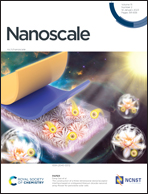The construction of a three-dimensional donor/acceptor interface based on a bilayered titanium dioxide nanorod array-flower for perovskite solar cells†
Abstract
Recently, organic–inorganic hybrid perovskite solar cells have been considered as the new generation of photovoltaic devices due to their excellent performance. However, their finite interfacial stability limits their further commercialization. How to improve their stability is one of the important issues in current scientific research. Herein, a bilayered titanium dioxide nanorod array-flower (B-TiO2-NAF) was prepared as an electron transport material for hybrid perovskite solar cells in order to overcome this difficulty. A device based on B-TiO2-NAF exhibits an excellent power conversion efficiency (PCE) of 21.8% due to its low electron trap density (ntrap), low carrier recombination resistance (Rs), facilitated electron injection, and reduced nonradiative recombination rate. The application of B-TiO2-NAF provides a stable three-dimensional (3-D) D/A interface and shortens the internal photoexciton diffusion distance. As a result, the device shows excellent long-term stability, which is maintained at over 83% of the initial efficiency after 30 days. Our work should be beneficial for the preparation of 3-D semiconductor materials and provides new insights into highly stable perovskite solar cells.

- This article is part of the themed collection: 2023 Nanoscale HOT Article Collection


 Please wait while we load your content...
Please wait while we load your content...